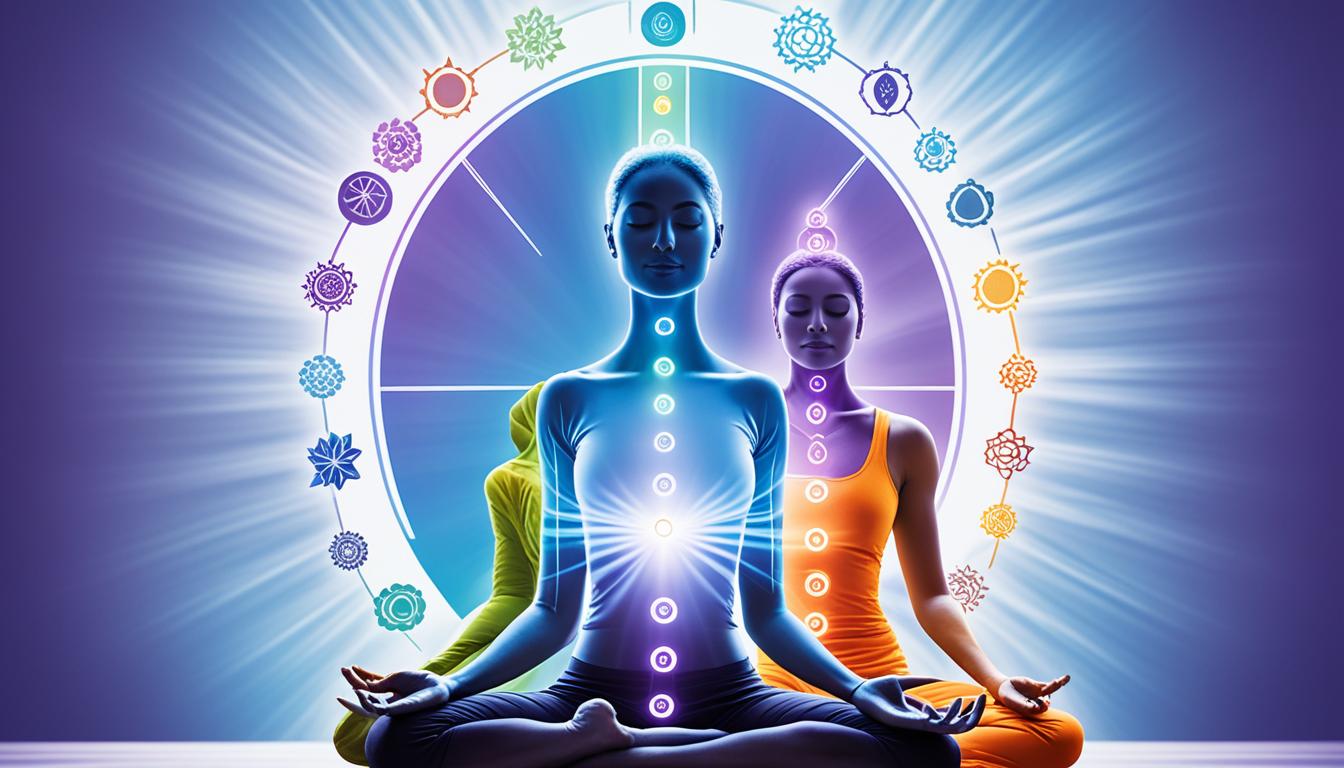Disclosure: This Post Contains Affiliate Links; We earn a commission on purchases.
In our fast-paced, digitally-driven world, it’s easy to feel overwhelmed by the constant influx of information and the demands of technology. The concept of mindful tech usage acknowledges the potential downsides of excessive screen time and digital addiction. By practicing mindfulness and setting boundaries, individuals can achieve a harmonious tech-life balance and enhance their digital wellbeing.
Key Takeaways:
- Practicing mindfulness and setting boundaries helps achieve a harmonious tech-life balance.
- Mindful technology use enhances digital wellbeing.
- Excessive screen time and digital addiction can have negative effects on overall well-being.
- Mindless technology use should be avoided to promote a mindful approach to technology.
- Utilizing mindful tech apps and tools can support a healthy relationship with technology.
The Impact of Technology on Well-being
Excessive use of technology can have a significant impact on mental, emotional, and physical health. It is crucial to understand and address the negative effects of technology on well-being to make informed decisions about mindful technology use.
The Challenges of Technology Addiction
Technology addiction is a growing concern in our digital world. Excessive reliance on devices and online platforms can lead to addictive behaviors, creating difficulties in managing screen time and causing withdrawal symptoms when disconnected. This addiction can impede our ability to focus on tasks, engage in face-to-face interactions, and find enjoyment in offline activities.
Reduced Attention Span
Technology overload, characterized by constant exposure to information and notifications, can readily contribute to a reduced attention span. The habit of quickly switching between tasks or constantly seeking stimulus from digital sources can diminish our ability to concentrate, affecting productivity, learning, and deep thinking.
Disrupted Sleep Patterns
Excessive technology use, especially before bedtime, can disrupt our sleep patterns. The blue light emitted by screens can interfere with the production of melatonin, a hormone that regulates sleep. This disruption can lead to difficulties falling and staying asleep, causing daytime fatigue and impacting overall well-being.
Social Comparison and Self-esteem
Social media platforms have created a fertile ground for social comparison, where individuals tend to compare their lives, achievements, and appearances with others. This constant comparison can lead to feelings of inadequacy, decreased self-esteem, and even depression, as people strive to meet unrealistic standards portrayed online.
Information Overload
In our technology-driven society, we are constantly bombarded with vast amounts of information. This overload can overwhelm our cognitive abilities, making it challenging to filter relevant information, discern credible sources, and process information effectively. As a result, our decision-making abilities may suffer, leading to stress and anxiety.
Excessive use of technology can negatively impact mental and emotional well-being, attention span, sleep quality, self-esteem, and cognitive processing. It is crucial to understand these effects and take proactive steps towards mindful and balanced technology use.
In the next section, we will explore the difference between mindful and mindless technology use and how it can contribute to our overall well-being.
Mindful vs. Mindless Technology Use
Technology has become an integral part of our daily lives, offering convenience, connectivity, and endless possibilities. However, it is important to differentiate between mindful and mindless technology use to foster a healthy relationship with our devices and avoid the pitfalls of technology addiction.
The Essence of Mindful Technology Use
Mindful technology use involves conscious and intentional engagement with our devices. It requires us to prioritize present-moment awareness and intentional interaction, allowing us to make deliberate choices about how we engage with technology.
By incorporating mindfulness into our digital experiences, we can enhance our overall well-being and find a harmonious balance between the digital and physical worlds. Mindful technology use empowers us to use technology as a tool for personal growth, productivity, and connection.
The Perils of Mindless Technology Use
In contrast, mindless technology use is characterized by addictive behaviors and a lack of awareness in our digital interactions. It often involves mindlessly scrolling through social media feeds, compulsively checking notifications, and losing track of time spent on screens.
Mindless technology use can lead to technology addiction, which can negatively impact our mental, emotional, and physical well-being. It can contribute to reduced attention spans, disrupted sleep patterns, and increased stress levels. By mindlessly consuming digital content without intention or moderation, we may miss out on real-world experiences and meaningful connections.
The Importance of Distinguishing Between Mindful and Mindless Technology Use
Recognizing the difference between mindful and mindless technology use is crucial for individuals to make informed choices about their digital habits. By understanding the potential pitfalls of mindless technology use, we can take proactive steps to cultivate a more intentional and balanced relationship with technology.
“Mindful technology use empowers us to use technology as a tool for personal growth, productivity, and connection.”
Distinguishing between the two allows us to engage with technology consciously, setting boundaries and prioritizing our well-being. With mindfulness, we can establish healthier digital habits, reduce distractions, and maintain a greater sense of control over our tech usage.
By embracing mindful technology use, we can harness the benefits of technology while mitigating its potential negative impact. Through intentional engagement, we can foster a more fulfilling and mindful digital experience.
Contrasting Mindful and Mindless Technology Use
| Mindful Technology Use | Mindless Technology Use |
|---|---|
| Prioritizes present-moment awareness | Engages in mindless scrolling and digital overconsumption |
| Uses technology as a tool for personal growth | Uses technology as a source of constant stimulation |
| Establishes boundaries and sets intentional tech usage | Allows technology to dictate time and attention |
| Fosters mindful and meaningful connections | Engages in superficial online interactions |
| Promotes overall well-being and digital balance | Contributes to technology addiction and imbalance |
Recognizing the differences between mindful and mindless technology use empowers us to take control of our digital lives. By adopting a more mindful approach, we can fully leverage the benefits of technology while safeguarding our well-being and nurturing a healthy relationship with our devices.
Practical Tips for Mindful Technology Use
When it comes to navigating the digital landscape in a mindful and balanced way, implementing practical tips can make a significant difference. By following these strategies, you can create a healthier relationship with technology and optimize your digital well-being.
Set Boundaries for Tech Use
To maintain a mindful approach to technology, it’s important to set clear boundaries. Establish dedicated tech-free times or locations to disconnect from screens and prioritize real-world interactions. By defining boundaries, you can regain control over your tech habits and ensure a more balanced lifestyle.
Manage Notifications to Reduce Distractions
Notifications can be a constant source of distraction and can interrupt your focus. Take control by managing your notification settings and silencing or turning off unnecessary alerts. By minimizing digital interruptions, you can cultivate a more focused and mindful environment.
Practice Mindful Screen Time
Instead of mindlessly scrolling through your devices, engage in mindful screen time. Before using technology, take a moment to breathe deeply and set an intention for your tech session. Stay present and aware of your digital interactions to avoid falling into the trap of unconscious browsing.
Incorporate Digital Detox Periods
Give yourself regular breaks from technology by incorporating digital detox periods into your routine. Designate specific times or days when you completely disconnect from screens and engage in offline activities. This intentional break from technology allows you to recharge and reconnect with the physical world.
Focus on Single-Tasking
In a world filled with constant distractions, single-tasking can help you regain focus and enhance productivity. Instead of multitasking, choose to dedicate your attention to a single activity at a time. By eliminating the urge to switch between tasks, you can cultivate a deeper level of presence and accomplish more.
Create Tech-Free Rituals
Integrate tech-free rituals into your daily life to establish a healthier balance. Designate specific periods during the day when you disconnect from technology and engage in activities that nourish your mind, body, and soul. Whether it’s dedicating time for meditation, journaling, or spending quality time with loved ones, these rituals provide a much-needed break from the digital realm.
Select Mindful Apps
When using technology, be intentional about the apps and tools you incorporate into your digital routine. Choose applications that align with your values and support your well-being. Mindful app selections can include meditation apps, focus timers, screen time tracking tools, and digital well-being platforms.
Regularly Reflect on Digital Habits
Take time to regularly reflect on your digital habits and evaluate how they align with your overall well-being. Consider engaging in digital check-ins, where you assess the impact of technology on your life. Reflecting on your relationship with technology empowers you to make informed choices and gradually reshape your habits for a healthier, more mindful approach.
Key Takeaways:
- Set boundaries for tech use to regain control over your digital habits.
- Manage notifications to minimize distractions and maintain focus.
- Practice mindful screen time by staying present and aware of your digital interactions.
- Incorporate digital detox periods to recharge and reconnect with the physical world.
- Focus on single-tasking to enhance productivity and reduce multitasking tendencies.
- Create tech-free rituals to establish a healthier balance in your daily life.
- Select mindful apps that prioritize your well-being and values.
- Regularly reflect on your digital habits and make adjustments as needed for a more mindful approach.
Digital Detox: Why and How?
A digital detox is a conscious decision to disconnect from digital devices for a designated period. By taking a break from constant connectivity, individuals can experience a range of benefits that contribute to their overall well-being.
The Benefits of Digital Detox
- Reduced stress and anxiety: Stepping away from digital distractions allows individuals to escape the mental and emotional strain associated with constant online engagement. It provides an opportunity to relax, unwind, and recharge.
- Improved sleep quality: Excessive screen time before bed can disrupt sleep patterns. Engaging in a digital detox promotes better sleep by reducing exposure to blue light and creating a calming environment for high-quality rest.
- Enhanced focus and productivity: Continuous notifications and constant multitasking can fragment our attention span. By disconnecting from digital distractions, we can regain focus, improve concentration, and optimize productivity.
- Increased presence in the real world: The over-reliance on digital devices can hinder genuine connections and experiences in the physical world. A digital detox creates space for individuals to be fully present, fostering more meaningful interactions and connection with themselves and others.
Planning a Digital Detox
When initiating a digital detox, it’s important to set clear intentions and establish a plan to ensure success. Here are a few steps to get started:
- Define the duration: Determine how long you want your digital detox to last. It could be a few hours, a full day, a weekend, or even longer.
- Inform others: Let family, friends, and colleagues know about your digital detox in advance, so they are aware of your unavailability during this time.
- Create alternative activities: Plan offline activities to fill the time you would typically spend on digital devices. Engage in hobbies, exercise, spend time in nature, read books, or connect with loved ones face-to-face.
- Establish boundaries: Set clear guidelines for yourself concerning which devices, apps, or platforms you will disengage from during the detox. Consider temporarily deleting social media apps or turning off notifications.
- Practice self-reflection: Reflect on the experience after the digital detox. How did it make you feel? What insights did you gain? Use this self-reflection to adjust your digital habits moving forward.
By planning and committing to a digital detox, you can regain control of your relationship with technology, prioritize your well-being, and create a healthier balance between the digital world and the real world.

Take a moment to visualize the benefits of a digital detox. Disconnecting from the digital world can be a transformative experience, allowing you to reduce stress, improve sleep, increase focus and productivity, and be more present in the real world.
Mindful Tech Apps and Tools
Mindful tech apps and tools are invaluable resources for individuals seeking to cultivate a balanced and intentional relationship with technology. These tools promote mindfulness, manage screen time, and enhance overall well-being in the digital age.
Meditation Apps
Meditation apps provide a convenient way to incorporate mindfulness practices into daily life. With guided meditation sessions, relaxing music, and breathing exercises, these apps offer a variety of techniques to reduce stress and improve mental well-being.
Focus Timers
Focus timers are effective tools for enhancing productivity and maintaining concentration. By breaking tasks into manageable intervals and incorporating short breaks, these timers help individuals stay focused and avoid distractions.
Screen Time Tracking Tools
Screen time tracking tools allow users to monitor and manage their digital usage. With insights into daily screen time, app usage, and notifications, these tools empower individuals to develop healthier screen habits and reduce excessive device dependency.
Notification Management Apps
Notification management apps enable users to control and customize their device notifications. By reducing unnecessary interruptions and selectively receiving only the most important notifications, individuals can minimize distractions and regain focus.
Digital Well-being Platforms
Digital well-being platforms offer comprehensive solutions by combining various tools and features to promote mindful tech usage. These platforms typically include screen time tracking, app usage reports, personalized recommendations, and tools for managing notifications and setting digital boundaries.
Mindful Journaling Apps
Mindful journaling apps provide a space for self-reflection and introspection. With prompts, gratitude lists, and mood tracking features, these apps enable users to cultivate mindfulness, boost self-awareness, and enhance emotional well-being.
Nature Sounds and Relaxation Apps
Nature sounds and relaxation apps offer immersive auditory experiences that facilitate relaxation, stress reduction, and mental clarity. Whether it’s rainforest sounds, calming ocean waves, or gentle meditative music, these apps provide a soothing escape from the demands of the digital world.
Community Support Apps
Community support apps connect individuals who share similar goals and challenges in navigating mindful tech usage. These apps provide a platform for sharing experiences, seeking advice, and fostering a sense of accountability and support in maintaining a healthy digital lifestyle.
Investing in mindful tech apps and tools empowers individuals to create a balanced and intentional relationship with technology. By incorporating these resources into their digital routines, users can enhance mindfulness, manage screen time, and prioritize their overall well-being in an increasingly connected world.
The Importance of Being Present
In today’s digital age, it’s easy to get caught up in the endless scrolling and multitasking that technology offers. However, being mindful of our tech usage and consciously resisting mindless scrolling can have a profound impact on our overall well-being. By focusing on the task at hand and practicing present-moment awareness, we can enhance our digital experiences and reduce distraction.
When we are fully present in the moment, we can engage more deeply with the content we consume and the tasks we undertake. Instead of mindlessly scrolling through social media feeds or jumping from one app to another, we can intentionally choose where to direct our attention. This allows us to make the most of our time and energy, ensuring that our digital interactions are meaningful and purposeful.
Resisting mindless scrolling also helps us overcome the addictive nature of technology. It’s all too easy to fall into the habit of constantly reaching for our devices and mindlessly consuming information. By being mindful of our tech usage and deliberately choosing when and how we engage with technology, we regain control over our digital habits.
“The greatest gift you can give someone is your time, because when you give your time, you are giving a portion of your life that you can never get back.”
By being present and mindful in our tech usage, we can savor the present moment and cultivate a greater sense of gratitude, connection, and fulfillment. We can fully appreciate the experiences that unfold before us, whether it’s having meaningful conversations with loved ones, immersing ourselves in a captivating book, or pursuing our passions and hobbies.
Acknowledging the importance of being present doesn’t mean completely avoiding technology. Rather, it’s about finding a balance and using technology intentionally and purposefully. It’s about setting clear boundaries, creating tech-free zones or rituals, and being mindful of our screen time.
Next time you find yourself reaching for your phone or mindlessly scrolling through social media, take a moment to pause, breathe, and ask yourself: “Is this the best use of my time right now? Could I be more present and mindful in this moment?” By incorporating such reminders into our daily lives, we can foster a healthier relationship with technology and make the most of our precious time.
| Benefits of Being Present | Mindful Tech Habits |
|---|---|
| Enhanced focus and productivity | Setting clear boundaries for tech use |
| Reduced stress and anxiety | Resisting mindless scrolling |
| Improved overall well-being | Practicing present-moment awareness |
| Deeper connection with the present moment | Mindful screen time management |
Applying Mindfulness Practices to Digital Activities
Incorporating mindfulness into our digital activities can significantly enhance our well-being and promote a healthier relationship with technology. By integrating simple yet powerful practices such as mindful breathing, setting intentions, and taking digital breaks, we can transform our digital experiences and cultivate a greater sense of presence and balance.
Mindful Breathing: Finding Calm in the Digital Storm
Before diving into our digital tasks, taking a moment to engage in mindful breathing can help us establish a calm and centered state of mind. Close your eyes, take a deep breath in, and exhale slowly. Pay attention to the sensation of the breath entering and leaving your body. By bringing awareness to our breath, we can anchor ourselves in the present moment and approach our digital activities with clarity and focus.
Setting Intentions: Navigating Social Media with Purpose
Social media can be a powerful tool for connection, but it can also lead us down the rabbit hole of mindless scrolling and comparison. To harness the positive aspects of social media, set specific intentions before logging in. Ask yourself what you hope to achieve or experience during your time on social platforms. It could be seeking inspiration, connecting with loved ones, or sharing something meaningful. By setting intentions, we bring purpose and awareness to our digital interactions, allowing us to use social media as a tool for personal growth and connection.
Taking Digital Breaks: Refreshing Mind, Body, and Spirit
It’s easy to get sucked into the endless vortex of digital distractions. Taking regular breaks from our devices is essential for resetting our minds and recharging our energy. Schedule short periods of time throughout the day to step away from screens and engage in activities that nourish your well-being. It could be going for a walk in nature, practicing mindfulness meditation, or engaging in a hobby you enjoy. By incorporating digital breaks into our routines, we create space to rejuvenate and reconnect with ourselves and the world around us.
Remember, technology is a tool that should serve us, not the other way around. By integrating mindfulness practices into our digital activities, we reclaim our power to use technology intentionally and in alignment with our values and well-being.
Achieving Mindful Tech Integration: Practical Tips
| Mindful Practices | Tips |
|---|---|
| Mindful Breathing | – Before checking emails or starting a digital task, take a few deep breaths to ground yourself and bring awareness to the present moment. – Set reminders throughout the day to pause and take mindful breaths. |
| Setting Intentions | – Reflect on your goals and values before engaging with social media or any digital platform. – Be mindful of the content you consume and ask yourself if it aligns with your intentions. |
| Taking Digital Breaks | – Schedule regular digital detox periods to disconnect from devices and engage in offline activities. – Use apps or timers to track and manage your screen time, ensuring you take breaks at regular intervals. |
By integrating mindful practices like mindful breathing, setting intentions, and taking digital breaks into our digital routines, we can create a more intentional and balanced relationship with technology. These practices empower us to navigate the digital landscape with greater awareness, presence, and well-being.
The Mindful Tech Mindset
Embracing a mindful tech mindset involves recognizing technology as a powerful tool for enrichment rather than a constant source of stimulation. It means being intentional and purposeful in how we interact with digital devices, apps, and platforms. By approaching each digital interaction with mindfulness and awareness, individuals can harness the benefits of technology while mitigating its potential negative impact on their well-being.
“Technology is best when it brings people together.” – Matt Mullenweg
When we adopt a mindful tech mindset, we shift our focus from mindless consumption to using technology with purpose and intention. Rather than allowing ourselves to be overwhelmed by the endless stream of notifications and content, we become more selective and mindful of our digital choices. We prioritize quality over quantity, ensuring that technology serves us rather than controlling us.
With a mindful tech mindset, we cultivate awareness of how technology affects our mental, emotional, and physical well-being. We become more attuned to the ways in which excessive screen time, digital distractions, and information overload can impact our lives. By recognizing these challenges, we can make conscious decisions to set boundaries, manage our digital habits, and find balance.
The Power of Technology as a Tool
One of the core principles of a mindful tech mindset is understanding that technology is a tool – a means to an end. Instead of mindlessly scrolling through social media feeds or seeking constant stimulation, we can leverage technology to enhance our lives and achieve specific goals. Whether it’s staying connected with loved ones, accessing information, or pursuing personal and professional growth, we can use technology intentionally to support our aspirations.
Using Technology with Purpose and Awareness
Mindful tech usage requires us to engage with technology consciously and deliberately. We can start by setting clear intentions for our digital activities, clarifying what we hope to achieve and how technology can contribute to those aims. By being proactive and intentional, we can avoid falling into mindless browsing or getting lost in digital distractions.
By adopting a more conscious and deliberate approach to technology, we can transform the way we interact with it. Instead of being passive consumers, we become active creators, using technology to enhance our lives, relationships, and well-being. – Unknown
In addition to setting intentions, it’s important to periodically assess and reflect on our relationship with technology. This includes taking breaks, practicing digital detox, and being mindful of our screen time. Regularly checking in with ourselves allows us to maintain a healthy balance and make adjustments as needed.
Choosing Digital Tools Mindfully
A mindful tech mindset extends to the tools and apps we use. It involves selecting digital resources that align with our values and support our well-being. For example, we can choose apps that promote mindfulness and relaxation, encourage focus and productivity, or help us establish healthy digital boundaries. By consciously curating our digital environment, we create a space that nurtures our overall well-being.

Embracing a mindful tech mindset empowers us to cultivate a healthier relationship with technology. By recognizing its role as a tool, approaching it with purpose and awareness, and making conscious choices about how we engage with it, we can navigate the digital landscape with mindfulness and intention. This mindset allows us to harness the full potential of technology while prioritizing our well-being and finding the balance we seek.
Conclusion
Mindful technology use is crucial in today’s digital world to achieve a harmonious tech-life balance and enhance digital wellbeing. By practicing mindfulness, setting boundaries, and utilizing mindful tech apps and tools, individuals can navigate the digital landscape in a way that supports their well-being and fulfillment.
Finding balance between the digital and physical worlds is key to maintaining a healthy relationship with technology. It allows individuals to connect more deeply with themselves, others, and the world around them. By being mindful of our tech usage, we can prioritize meaningful interactions and experiences while minimizing the negative impact of excessive screen time and digital overload.
By incorporating practical tips and strategies for mindful technology use, individuals can create a digital environment that promotes their overall well-being. Taking regular digital detoxes, using mindful tech apps, and applying mindfulness practices to digital activities all contribute to a more conscious and intentional approach to technology.
Source Links
- https://it.osu.edu/learner-technology-handbook/ch4/mindful-technology-use
- https://medium.com/@raumze1t/the-art-of-mindful-tech-finding-balance-in-a-digital-world-11c752e68d2f
- https://medium.com/powercreativityinfluence/mindful-technology-use-e3e54ff2bffe
Ryan Conlon is a passionate advocate for mindfulness and meditation, dedicated to helping others discover the transformative power of these practices in their lives. As the founder of Daily Meditation, Ryan’s mission is to provide a sanctuary for individuals seeking peace, clarity, and well-being amidst the chaos of modern life. With a background in psychology and years of personal experience with meditation, Ryan brings a wealth of knowledge and insight to his work. Through Daily Meditation, he shares practical guidance, inspirational content, and expert resources to support others on their journey toward greater mindfulness, resilience, and inner peace.
Subscribe to Our Newsletter

















